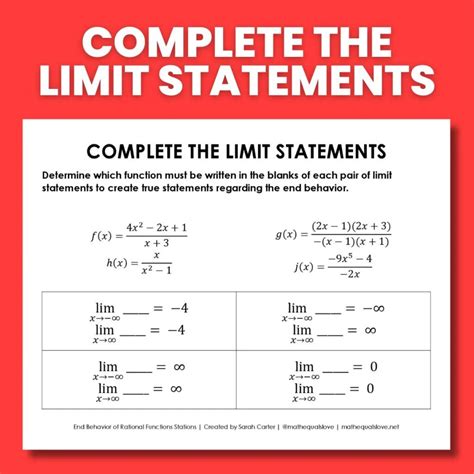In mathematics, the end behavior of a function describes how the function behaves as the input approaches infinity or negative infinity. This behavior can be determined using limit statements.

Limit Statements
A limit statement is a mathematical expression that describes the value that a function approaches as the input approaches a certain value. The general form of a limit statement is:
lim_(x->a) f(x) = L
where:
- lim is the limit operator
- x->a indicates that x is approaching the value a
- f(x) is the function being evaluated
- L is the limit value
For example, the following limit statement means that as x approaches 2, the value of the function f(x) approaches 5:
lim_(x->2) f(x) = 5
Determining End Behavior
The end behavior of a function can be determined by evaluating the limits of the function as the input approaches infinity or negative infinity.
Horizontal Asymptotes
If the limit of the function as x approaches infinity or negative infinity is a finite value, then the function has a horizontal asymptote at that value. A horizontal asymptote is a horizontal line that the function approaches but never touches.
For example, the function f(x) = 1/x has a horizontal asymptote at y = 0. This is because:
lim_(x->∞) 1/x = 0
lim_(x->-∞) 1/x = 0
Vertical Asymptotes
If the limit of the function as x approaches a certain value is infinity or negative infinity, then the function has a vertical asymptote at that value. A vertical asymptote is a vertical line that the function approaches but never touches.
For example, the function f(x) = 1/(x-1) has a vertical asymptote at x = 1. This is because:
lim_(x->1) 1/(x-1) = ∞
Slant Asymptotes
If the limit of the function as x approaches infinity or negative infinity is not a finite value and the function is not undefined at that value, then the function has a slant asymptote. A slant asymptote is a non-horizontal line that the function approaches but never touches.
For example, the function f(x) = x + 1/x has a slant asymptote at y = x. This is because:
lim_(x->∞) x + 1/x = ∞
lim_(x->-∞) x + 1/x = -∞
Applications of End Behavior
The end behavior of a function can be used to determine the following information about the function:
- The range of the function
- The domain of the function
- The intervals on which the function is increasing or decreasing
- The intervals on which the function is concave up or concave down
This information can be used to graph the function and to solve problems involving the function.
End Behavior and Calculus
The end behavior of a function is closely related to the derivative of the function. The derivative of a function is a measure of the instantaneous rate of change of the function. The end behavior of a function can be used to determine the following information about the derivative of the function:
- The sign of the derivative at infinity and negative infinity
- The intervals on which the derivative is positive or negative
- The intervals on which the derivative is increasing or decreasing
This information can be used to find the critical points of the function and to determine the intervals on which the function is increasing or decreasing.
